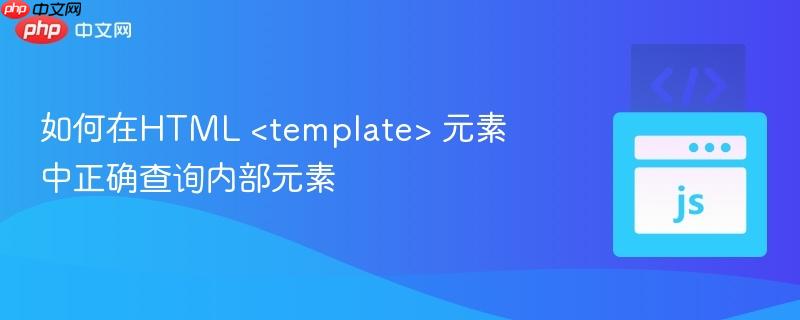 元素中正确查询内部元素
" />
元素中正确查询内部元素
" />
html 元素提供了一种在页面加载时不会被渲染的机制,用于存储可复用的html内容。它允许开发者定义一段html结构,这段结构在被激活(例如通过javascript克隆并添加到dom)之前,其内容是“惰性”的,不会影响文档的渲染或被脚本执行。这种特性使得 成为构建web组件、延迟加载内容或创建复杂ui模式的理想选择。
当尝试直接在 元素上执行DOM查询操作时,例如使用 template.getElementsByTagName('link'),我们可能会发现无法获取到预期的内部元素。这是因为 元素内部的HTML内容并不直接属于文档的活动DOM树。以下是一个常见的错误尝试:
假设我们有以下HTML结构:
<template></template> <template> <link/> </template> <template></template>
现在,我们尝试使用JavaScript查询这些模板内部的 元素:
const templates = [...document.getElementsByTagName('template') || []];
console.log(`Found ${templates.length} template(s)`); // 输出:Found 3 template(s)
templates.map((template) => {
// 错误:直接在template元素上查询
const links = [...template.getElementsByTagName('link') || []];
console.log(`Found ${links.length} link(s)`); // 预期找到1个,实际输出:Found 0 link(s)
});上述代码的输出会显示 Found 0 link(s),即使第二个 内部明确包含了一个 元素。这种行为的根本原因在于, 元素就像一个特殊的容器,它的内容被封装在一个 DocumentFragment 中,而不是直接暴露给其父元素(即 自身)的子节点列表。因此,对 元素本身进行查询操作,是无法触及到其内部的封装内容的。
立即学习“前端免费学习笔记(深入)”;
要正确访问和查询 元素内部的DOM内容,我们需要使用其 content 属性。template.content 属性返回一个 DocumentFragment 对象,该对象包含了模板的所有子节点。DocumentFragment 是一个轻量级的文档,可以作为其他DOM节点的临时容器,并且可以在其上执行标准的DOM查询方法,如 querySelector 或 querySelectorAll。
以下是修正后的代码示例,演示了如何通过 template.content 属性来正确查询模板内部的 元素:
// 推荐使用querySelectorAll获取所有template元素,因为它支持更复杂的选择器
const templates = [...document.querySelectorAll('template') || []];
console.log(`Found ${templates.length} template(s)`);
templates.map((template) => {
// 正确:通过template.content属性访问DocumentFragment,然后进行查询
const links = [...template.content.querySelectorAll('link') || []];
console.log(`Found ${links.length} link(s)`);
});配合前面提到的HTML结构:
<template></template> <template> <link/> </template> <template></template>
运行修正后的JavaScript代码,将得到预期的输出:
Found 3 template(s) Found 0 link(s) Found 1 link(s) Found 0 link(s)
这清楚地表明,通过 template.content 访问 DocumentFragment 是查询 内部元素的关键。
DocumentFragment 的作用:DocumentFragment 是一个轻量级的文档对象,它不属于文档树的任何部分。在将节点添加到 DocumentFragment 中时,它们不会触发DOM重绘或回流,只有当 DocumentFragment 本身被添加到文档树时,才会发生一次性的重绘和回流。这对于批量操作DOM节点具有性能优势。在 的场景中,content 属性返回的 DocumentFragment 封装了模板的实际内容。
querySelectorAll 的优势: 示例中使用了 querySelectorAll。相较于 getElementsByTagName,querySelectorAll 提供了更强大的选择器功能,可以使用CSS选择器语法来选择元素,这在处理复杂DOM结构时更为灵活和强大。对于 DocumentFragment 而言,两者都可以使用,但 querySelectorAll 通常是更推荐的选择。
模板内容的激活与使用: 仅仅查询到模板内部的元素并不意味着它们已经呈现在页面上。要使模板内容可见,通常需要克隆 template.content 并将其添加到文档的活动DOM树中。例如:
const targetTemplate = document.querySelector('template:nth-of-type(2)'); // 获取第二个模板
if (targetTemplate) {
// 使用 document.importNode 深度克隆 DocumentFragment 的内容
const clone = document.importNode(targetTemplate.content, true);
// 将克隆内容添加到文档的某个元素中,例如 body
document.body.appendChild(clone);
}document.importNode() 方法用于从另一个文档或 DocumentFragment 导入节点。第二个参数 true 表示进行深度克隆,包括所有子节点。
浏览器兼容性: 元素在现代浏览器中得到了广泛支持(包括Chrome, Firefox, Safari, Edge等),可以放心使用。
在JavaScript中处理HTML 元素时,务必记住其内部内容被封装在一个 DocumentFragment 中。要正确地查询或操作这些内部元素,必须首先通过 template.content 属性访问这个 DocumentFragment,然后在此 DocumentFragment 上执行标准的DOM查询方法(如 querySelectorAll)。理解这一核心机制是有效利用 元素进行前端开发的关键,能够帮助开发者避免常见的查询错误,并更高效地管理可复用HTML内容。
以上就是如何在HTML 元素中正确查询内部元素的详细内容,更多请关注php中文网其它相关文章!

HTML怎么学习?HTML怎么入门?HTML在哪学?HTML怎么学才快?不用担心,这里为大家提供了HTML速学教程(入门课程),有需要的小伙伴保存下载就能学习啦!

Copyright 2014-2025 https://www.php.cn/ All Rights Reserved | php.cn | 湘ICP备2023035733号